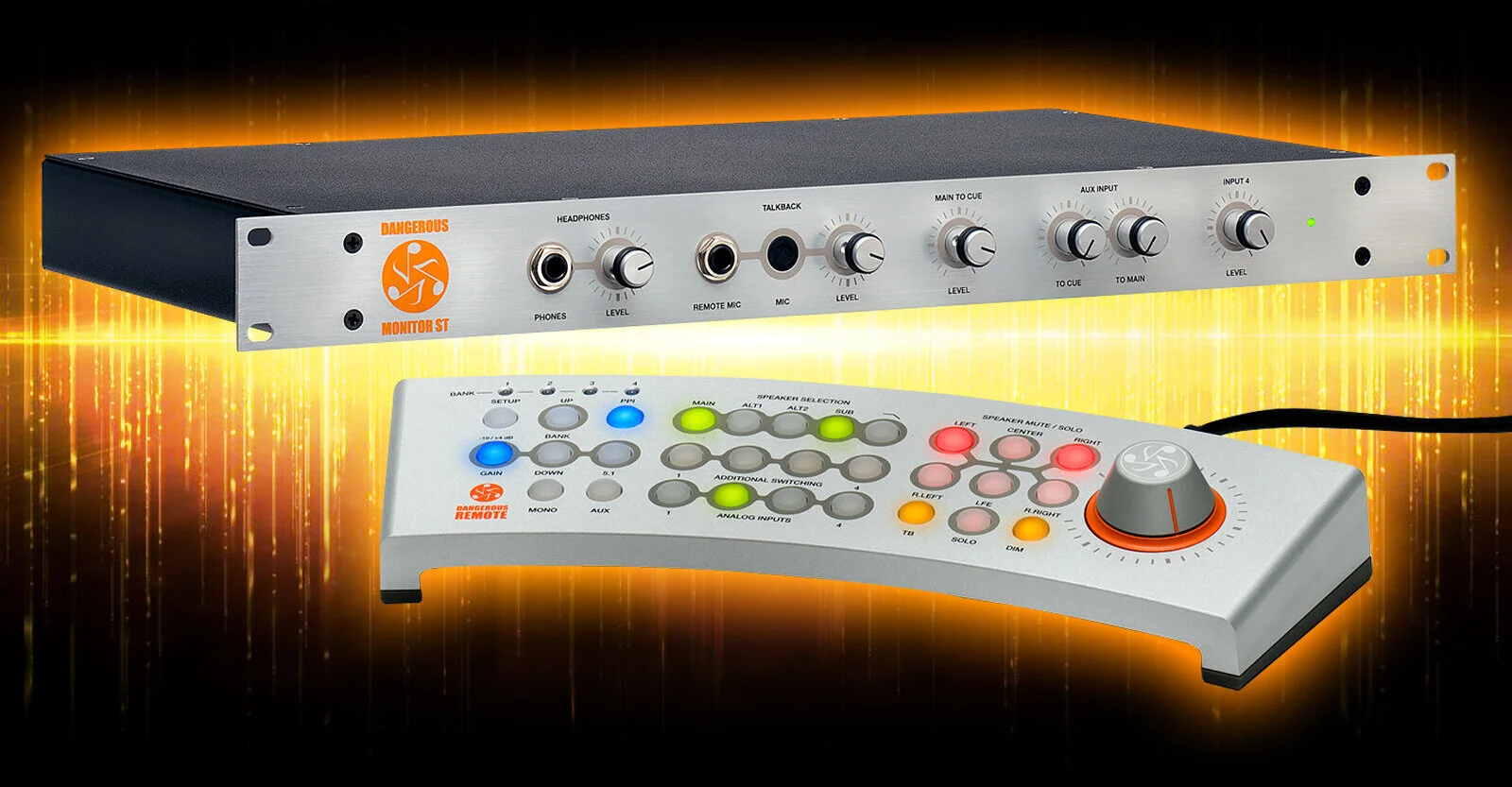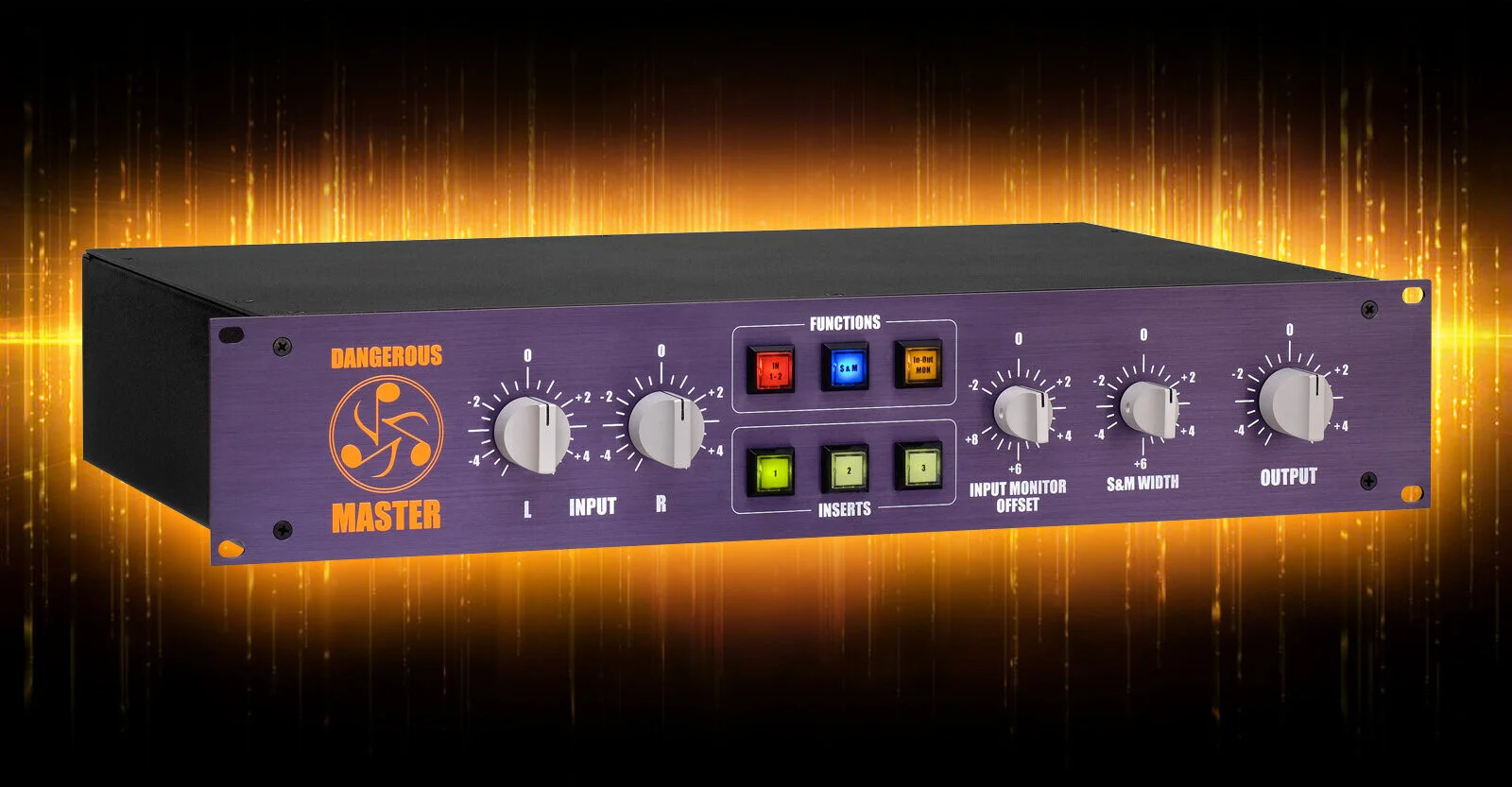ELECTRONIC MUSICIAN REVIEW: MONITOR ST
by Eli Crews
For years, people in the recording industry have been predicting the death of the console. With mixing taking place inside computers and summing boxes, and moderately priced outboard preamps and EQs in abundant supply, the large-format console has been diminishing in popularity in small-to-midsize studios for some time.
What has really driven the nail into the mixing desk’s coffin, though, is the advent of the monitor-management system, which offers functionality formerly found only in a console’s center section. Dangerous Music, already a leading force in high-end summing boxes, has a new product in this category: the Monitor ST Stereo Monitor Control System (see Fig. 1). Composed of a main unit and a wired remote control, it offers functions such as input and speaker switching, cue and talkback, and headphone amplification.
Outside the Box
The Monitor ST unit itself is a 1U-rackmount, brushed-aluminum box with the distinctive Dangerous logo screened in soft orange on the far left. On its face are ¼-inch jacks for an external talkback mic and headphones, and rubber-lined knobs for headphone, talkback mic, Main-to-Cue, Aux-to-Main, Aux-to-Cue, and Input 4 levels. (The Input 4 control lets you adjust the level of a CD player or other source that’s plugged through Input 4, facilitating accurate A/B comparisons.) Also on the front panel is the internal electret talkback mic.
On the back of the unit (see Fig. 2), you’ll find two 25-pin D-sub connectors. One is for the four main stereo inputs and the other for the four stereo outputs, which are meant to feed power amps or powered speakers. The connectors are wired according to the Tascam standard, so if you happen to have cabling around for a DA-38 or DA-88, you might be good to go for your Monitor ST I/O. If not, expect to have to make or buy such a harness before you can get audio flowing through the Monitor ST. (Dangerous recommends Redco cables [www.redco.com] for this purpose.)
The rear panel is also home to a pair of female XLR jacks for the stereo Aux input. The other jacks on the back are a mono XLR Slate output, a stereo unbalanced XLR for the powered-cue output, an XLR jack for an additional talkback remote switch, an RJ-45 jack for the included remote cable, and a DC-in jack for the hefty lump-in-the-line power supply.
Remotely Speaking
The remote, which is included with the Monitor ST, is a sleek crescent shape about 12 inches in length. Other than the various level controls on the face of the rackmounted unit, all business takes place at the remote, which crams an incredible amount of functionality into a compact package.
Starting at the right, the volcano-shaped volume control, an absolute position encoder, has 32 detented positions by which you can achieve extremely accurate volume consistency, down to a 0.02 dB error margin. This is accomplished using the Computer Controlled Analog Stepped-Attenuator Gain System, which, according to the Dangerous literature, is far superior to the VCA (voltage-controlled amplifier) or DCA (digitally controlled amplifier) circuits widely used in similar remote volume controls. A minor trade-off is that if you’re standing near the rack unit, you can hear the mechanical noise of the relays switching when you turn the volume knob. However, this noise is in the room only and has no effect on the actual audio that’s passing through the unit.
In addition to the exquisite volume control, the remote offers switching between the four stereo line inputs (five including the Aux input, which can be blended with any of the other four inputs) and the four stereo line outputs, speaker mutes, speaker solos, a dim function, mono summing, and a talkback button. The buttons are color coded by functionality and glow a gorgeous soft green, orange, red, or blue when selected.
The Setup button allows you to change certain parameters, such as level offsets for inputs and speaker feeds. You can designate whether or not the subwoofer output (Output 4) is included when you select Main, Alt 1, or Alt 2, and whether or not the subwoofer gets a 57 Hz lowpass filter on any output set.
Also included is a programmable gain boost to bring any -10 dBV input up to +4 dBu, and the Dim switch and the Aux input can be set (independently) to engage automatically when you press the Talkback button (more about this later).
Lastly, there’s a button labeled PPI, which stands for Producer Pacification Indicator. Think of this as a visual placebo, which can trick a producer’s ears into hearing any change they want you to make.
Main Event
Dangerous Music has built its stellar reputation by using the highest-quality components in uncompromising designs, so I was very excited to “hear” my first piece of Dangerous gear. The quotation marks are there because the whole philosophy behind the Monitor ST is that you don’t hear the unit itself; it is designed to pass your audio through its circuitry completely unscathed.
I A/B’d it, as much as that was possible, against my Amek Einstein console’s center section, as well as against a widely available and less expensive monitor-management unit. Because doing A/B comparisons required plugging and unplugging speakers, it was only over longer periods of listening that I could make real qualitative assessments. I did conclude that the Monitor ST gave me a much cleaner, deeper picture of my reference mixes than the less expensive unit. When I compared the sound of the Monitor ST with my console’s center section, the differences were subtler. That is to say, they both sounded great.
On a functional level, the Monitor ST trumps most high-end consoles’ monitoring features, with the amount of control over input and output levels, the subwoofer-management controls, and the absolute position encoder. Even people who won’t be ditching their consoles anytime soon, like myself, can benefit from the Monitor ST.
Yakety Yak
The talkback features are extremely flexible. The talkback mic on the rackmount unit is a highly sensitive omnidirectional electret, which picks up your voice even when you aren’t facing it. It picked up regular speaking voices from all the way across my 25-foot-long control room. This is mostly a good thing, but it did cause me to have to ask band members hanging out in the control room to be quiet a little more often than usual. If you have the unit mounted out of range of the built-in mic (like in a closet), there is a high-impedance external mic input, which you can drive with a common dynamic mic and inexpensive impedance-matching transformer. Plugging into this jack disables the front-panel mic.
The Talkback button itself is one of the many “Momentoggle” buttons on the remote. This term describes the following behavior: when the button is “pressed,” or pushed for less than a half second, the switch is latching, meaning it stays on when you let go; if the button is “held,” or pushed for more than a second, it functions as a momentary switch, and deselects itself when it is released. It is actually quite clever of the Dangerous designers to implement such a feature, and it surely took some engineering feats. The ability to press the Monitor ST’s Talkback button once and be able to talk as long as you want without having to hold it down is greatly appreciated.
It does take some getting used to, though, and I would love the ability to disable the Talkback button’s Momentoggle capabilities when needed. I often found that I had inadvertently left the button latched on, and band members were frequently saying less-than-kind things about their fellow musicians in the next room.
Next on the list of cool features is the talkback remote jack, for which I wired up a simple switch at the end of a mic cable, as specified in the manual. This is a welcome addition for most sessions, because a producer or bandleader can communicate with the sequestered musician without having to ask the engineer to repeatedly press the button. One last great feature is the addition of the Slate output, which lets you either send the talkback signal to a loudspeaker in the live room or print it directly to disk or tape.
Cue It Up
The Cue output is an amplified, stereo signal meant to feed a passive attenuator box. I was a little worried about sending this unbalanced signal to my headphone amps, into which I had previously been feeding a balanced, line-level signal over 60 feet or so of cabling. My fears were unfounded; once I got the gain staging right with the Cue level control, my headphone amps were happy to receive (and reamplify) this signal, with nary a hum or buzz.
The Cue output can be fed whatever is going to the control room monitors or whatever is hooked up to the Aux input, or a blend of both. My only small beef with the Cue system is that the headphone jack on the front of the unit mirrors whatever is being sent out the Cue output on the back of the unit. It would be great to be able to monitor what is going to the speakers on headphones without also sending that out to the talent.
ST for Me
I have thoroughly enjoyed the addition of the Monitor ST to my studio. The precision of its volume control; the clean, clear audio path; and the extensive input, speaker, and cue feature sets have all enhanced my daily studio experience.
There were a couple of features that I wished were on this unit, such as digital inputs and a Dangerous-caliber D/A converter. It turns out that the company was thinking along similar lines, because both of those features will be part of a 1U expansion unit for the Monitor ST that’s due out later this year (another expansion unit, the Monitor SR, which adds 5.1 surround monitoring, is already available).
In a market flooded with inexpensive solutions to console-free monitoring problems, the Dangerous Music Monitor ST stands out as a truly professional alternative. You’ll pay a few extra bucks for it, but quality like this is, in the long run, well worth the price. Especially given the Monitor ST’s expandability to 5.1 (and beyond), it is a true investment in every sense of the word, which may just be the best praise any piece of gear can garner.



